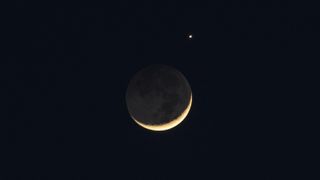See Venus and the moon dance with the 'Seven Sisters' during the Lyrid meteor shower Saturday
The crescent moon, Venus and the Pleiades will reach conjunction during the peak of the Lyrid meteor shower this Saturday. Here's how to watch the stunning show.

Stargazers are set for a spectacular show this Saturday (April 22), as the moon and Venus — the two brightest objects in the night sky — will appear as if they are about to collide amid a meteor shower, all while set against the backdrop of a stunning star cluster.
Venus will appear 6 degrees above and to the left of the waxing crescent moon by Saturday, with the Pleiades star cluster — a group of seven visible (and many more dim) stars popularly known as the "Seven Sisters" — about the same apparent distance below a beautiful and slender crescent moon, according to NASA (opens in new tab).
As if that weren't enough of a sight, the sky will also be flecked with "shooting stars" from the Lyrid meteor shower, which will peak Saturday evening to Sunday morning. The Lyrids are best witnessed in a dark, clear location. Weather permitting, as many as 18 meteor streaks per hour may be visible during this window, according to the American Meteor Society (opens in new tab).
Related: 100,000-year-old story could explain why the Pleiades are called 'Seven Sisters'
For weeks, the moon and Venus have been inching toward the point where they appear closest to each other in Earth's sky, known as a conjunction. This phenomenon, which occurs once every few months between the moon and the other planets in the solar system, is a trick of perspective from our 2D view of the night sky. The moon and Venus are, of course, actually millions of miles apart, and the Pleiades are even farther away, at 444 light-years from Earth.
You won't need a telescope or binoculars to see any of the cast in this cosmic drama, although viewing equipment will give you significantly more detail than the naked eye. If you want to use equipment to watch the show, see our recommendations for the best binoculars for stargazing.
With or without binoculars, catching the conjunction requires looking low along the western horizon just after sunset to see the crescent moon and the sparkling Pleiades hang below the brilliant Venus. On the darkened limb of the crescent moon, you should also see a glint, which has been reflected from Earth onto the moon and is known as Earthshine. If the sky is clear, flecks of fireballs from the Lyrid meteor shower will be visible.
Meteor showers occur when debris from a comet's tail vaporizes high up in Earth's atmosphere, making the dust and ice shed from the comet appear as a glowing trail of heated atmospheric gas. The burning sky furrows made by the Lyrids — one of the oldest known meteor showers and first discovered in China around 687 B.C. — are fragments from Comet Thatcher.
Streaming particles of space debris from Comet Thatcher have been visible from Earth for more than 2,600 years and strike our planet every April at speeds of around 29 miles per second (47 kilometers per second) as Earth's orbit takes us through Thatcher's debris tail, according to NASA (opens in new tab). Thatcher is traveling slowly around the sun, making a complete orbit once every 415 years.
In the background hang the Pleiades, named after the seven daughters of Atlas and Pleione in Greek mythology. According to myth, Atlas — one of the Titans and a cousin of Zeus, the king of the gods — rebelled against Zeus and was punished by being forced to forever bear the heavens on his broad shoulders. To ameliorate his cousin's eternal sentence, Zeus placed Atlas' grieving daughters in the heavens so that they could accompany their father.
If you can't catch Saturday's spectacle from your location, you can watch a livestream of the conjunction, as seen from Rome, courtesy of the Virtual Telescope Project (opens in new tab). The stream will begin at 2:30 p.m. EDT (1830 GMT on Saturday, April 22).
Live Science newsletter
Stay up to date on the latest science news by signing up for our Essentials newsletter.

Ben Turner is a U.K. based staff writer at Live Science. He covers physics and astronomy, among other topics like tech and climate change. He graduated from University College London with a degree in particle physics before training as a journalist. When he's not writing, Ben enjoys reading literature, playing the guitar and embarrassing himself with chess.
Most Popular

By Harry Baker